Chris nebraska
Download as pptx, pdf0 likes440 views
Nebraska's flag, motto, capital, state bird, and flower are presented along with facts about the state's population and governor. The presentation concludes with a thank you for viewing the PowerPoint.
1 of 11
Download to read offline
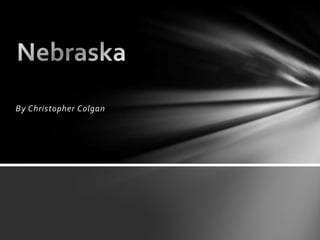
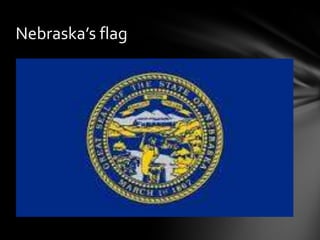

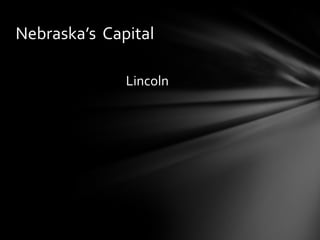
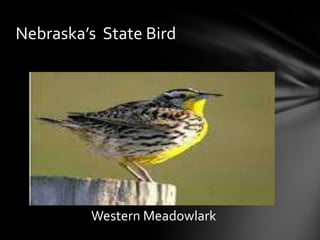
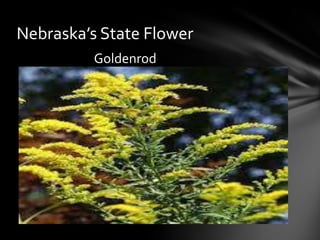


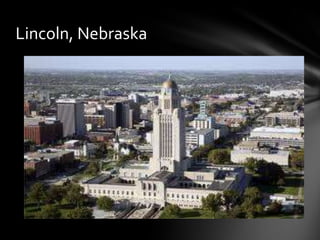

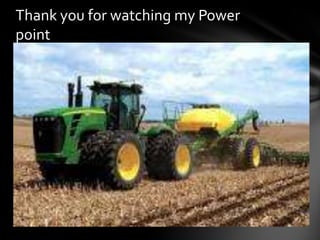
Ad
Recommended
Maine
MaineStacia Herson
Ěý
Maine's motto is "Dirigo" which is Latin for "I direct or I lead". The state bird is the Black Chickadee and the state flower is the White Pine Cone and Tassle. The population of Maine in 2000 was approximately 1.329 million people. The capital of Maine is Augusta and the current governor is Paul LePage.Minnesota fl
Minnesota flboyl0074
Ěý
Minnesota has a population of over 5 million people and is known for its 11,842 lakes, 4 seasons, farms, forests, small towns, and the beginning of the Mississippi River located in Itasca State Park. Minneapolis is the largest city in the state with a population of 390,131, located on the Mississippi River, and part of a larger urban area of 3.5 million people known for its skyline, arts, music scene, and people.Minnesota
MinnesotaStacia Herson
Ěý
Minnesota is known as the "Land of 10,000 Lakes" with a population of over 5 million people. Its state bird is the Common Loon, state flower is the Lady Slipper, and its capital and largest city is Saint Paul. Mark Dayton currently serves as the governor of Minnesota and can be contacted at the state capitol building in Saint Paul.3 states of matter
3 states of matterStacia Herson
Ěý
Gases have particles that move freely and expand to fill their container. Liquids have a definite volume but take the shape of their container as their particles move past each other. Solids have a definite shape and volume as their particles vibrate in place in either a repeating crystalline pattern or random amorphous arrangement. Changes in temperature can cause changes between these three states, such as melting from solid to liquid or evaporating from liquid to gas.North dakota
North dakotaStacia Herson
Ěý
The document provides information about the state of North Dakota, including its motto ("Liberty and Union, Now and Forever, One and Inseparable"), state bird (western meadowlark), state flower (wild prairie rose), total population (672,591 people), state flag, governor (Jack Dalrymple), and capital city (Bismarck).Noah nickoloff
Noah nickoloffStacia Herson
Ěý
The document provides key facts about the state of Oklahoma, including its state motto "Labor Omnia Vincit", state bird the Scissor Tailed Fly Catcher, state flower the Rosa 'Oklahoma', current population of 3,814,820 people, and capital city of Oklahoma City. It also lists the state governor as Mary Fallin and provides her email and mailing address.Power point
Power pointStacia Herson
Ěý
The document discusses New York state, mentioning its motto of "Excelsior", Eastern Blue Birds, the American flag, red roses, and a population of 19.57 million people. It also provides contact information for Governor Andrew Cuomo of New York, including his fax number, telephone number, and email address.Idaho
IdahoStacia Herson
Ěý
Gus Spradley wrote an article about Idaho Governor C.L. "Butch" Otter providing key biographical details in 3 sentences or less. The article notes that as of 2012 Idaho's population was 1.60 million, and it provides Governor Otter's name, address, phone number, spouse's name, birthdate, profession as agribusiness, religion as Roman Catholic, and email address. It also lists Boise as his place of residence.Colorado powerpoint by tristan
Colorado powerpoint by tristanStacia Herson
Ěý
Colorado's motto is "Nil Sine Numine," meaning "Nothing without providence." The state bird is the Lark Bunting and the state flower is Aquilegia saximontana. According to a 2013 count, over 5.2 million people lived in Colorado, whose capital and largest city is Denver. Governor John W. Hickenlooper leads the state from his office located in the 136 State Capitol building in Denver.California
CaliforniaStacia Herson
Ěý
The document provides information about California's state symbols, governor contact information, population statistics, and facts. The Golden Poppy and California Quail are the state flower and bird. Jerry Brown is the governor and can be contacted at his Sacramento office or by email. California's population in 2012 was over 38 million people and its motto is "Eureka!". Sacramento is the capital city.Alaska
AlaskaStacia Herson
Ěý
This document appears to be a letter from Lucas Oelkers to Alaska Governor Sean Parnell regarding three topics: North to the Future, Willow Partimagan, and Forget-Me-Not. The letter also includes a post office box address and email for the governor in Juneau, Alaska.Massachusetts
MassachusettsStacia Herson
Ěý
Massachusetts' state motto is "By the sword we seek peace, but peace only under liberty." The state bird is the black-capped chickadee which does not migrate and lives in forests and suburbs. The state flower is the Mayflower, also known as Epigaea repens, which is endangered with few left on Earth. The population of Massachusetts is over 6.7 million people and its capital and largest city is Boston.Minnesota chase
Minnesota chaseStacia Herson
Ěý
Minnesota's state bird is the loon, its state flower is the lady's slipper, and its 2010 population was over 5.3 million people. The document provides basic information about Minnesota's motto, bird, flower, population, flag, governor Mark Dayton and his address, and mentions the city of St. Paul.Powerpoint
PowerpointStacia Herson
Ěý
This document provides information about the state of Wisconsin including its motto, map, state bird, flower, population in 2012-2013, flag, governor Scott Walker and his contact information, capital of Madison, and mentions Wisconsin people, places and food.Montana
MontanaStacia Herson
Ěý
Montana's motto refers to gold and silver, it has a population of 1.005 million people, and its state bird is the Western Meadowlark. The governor is Steven Bullock and the capital city is Helena, located among the Montana mountains near the Missouri River.Powerpoint
PowerpointStacia Herson
Ěý
This document discusses the three states of matter: solids, liquids, and gases. It provides details about the properties of each state, including that solids have a definite shape and volume, liquids have a definite volume but take the shape of their container, and gases have no definite shape or volume. It also discusses concepts like surface tension, viscosity, Boyle's law, and how energy must be added or removed for substances to change states.Three States of Matter
Three States of MatterStacia Herson
Ěý
The document discusses the three states of matter: solids, liquids, and gases. It describes their key properties - solids have a definite shape and volume, liquids take the shape of their container but have a definite volume, and gases have no definite shape or volume. Examples are given for each state, such as desks for solids, water and milk for liquids, and oxygen and helium for gases. The document also covers concepts like surface tension in liquids and Charles' Law regarding how temperature affects a gas's volume.3 states of matter
3 states of matterStacia Herson
Ěý
This document discusses the three states of matter: solids, liquids, and gases. It defines each state and provides examples. Solids have particles that do not move freely, liquids have particles that flow freely but take the shape of their container, and gases have particles that are far apart and move freely. The document also discusses how matter can change states through processes like melting, boiling, freezing, and condensation. It introduces Charles' and Boyle's laws about the relationships between gas temperature, pressure, and volume.Powerpoint
PowerpointStacia Herson
Ěý
The document discusses the three states of matter: solids, liquids, and gases. It describes their key properties - solids have a definite shape and volume, liquids have a definite volume but take the shape of their container, and gases have no definite shape or volume. Examples of each state are provided.The three states of matter
The three states of matterStacia Herson
Ěý
This document discusses the three states of matter - solid, liquid, and gas. It provides details about the properties and behaviors of each state. Solids have a definite shape and volume, with molecules moving slowly. Liquids have no definite shape but a definite volume, with molecules moving faster than solids. Gases have no definite shape or volume, with molecules moving very quickly. Examples of each state of matter are also given.3 states of matter !!!!!!!
3 states of matter !!!!!!!Stacia Herson
Ěý
This document discusses the three states of matter: solids, liquids, and gases. It provides examples of each state and describes their key properties. Solids have a definite shape and volume, with particles that are close together and move slowly. Liquids have a definite volume but not shape, with particles that can slide past one another. Gases have no definite shape or volume, and their particles move quickly and are far apart with empty space between them. Examples are given for common substances that exist in each state of matter.Three states of matter
Three states of matterStacia Herson
Ěý
This document describes the three states of matter - solids, liquids, and gases. It defines each state and provides examples. Solids have a definite shape and volume, with particles that are close together and vibrate in place. Liquids have a definite volume but take the shape of their container, with particles that can move freely but not change the overall volume. Gases have no definite shape or volume, with particles that move quickly and freely between areas of empty space.The States of Matter
The States of MatterStacia Herson
Ěý
The document discusses the three states of matter - solids, liquids, and gases. It describes their key properties: solids have a definite shape and volume, with particles that vibrate in place; liquids have a definite volume but take the shape of their container, with particles that can slide past one another; gases have no definite shape or volume, with particles that move quickly and break away from each other. Examples of different materials in each state are provided.Mass and volume
Mass and volumeStacia Herson
Ěý
Mass is the amount of matter in an object and can be measured using a spring scale by tying a string to the object and pulling it. Volume is the amount of space an object takes up and can be calculated by multiplying length, width, and height or measured for liquids using containers like cups and beakers.Mass and volume
Mass and volumeStacia Herson
Ěý
Mass is the amount of matter an object contains and can be measured using a scale or balance. There are two common ways to measure mass - placing an object on one side of a scale and adding weights to the other side until balanced, or using a digital scale. Volume is the amount of space an object occupies, which can be calculated by multiplying an object's length, width, and height or measured using a graduated cylinder filled with water.Mass and volume! logan
Mass and volume! loganStacia Herson
Ěý
Mass is the amount of matter in an object measured in units like grams or pounds. It can be calculated by weighing an object on a standard scale or electric scale. Volume is the amount of space an object takes up and can be calculated using the length, width, and height formula (LWH) or by submerging the object in a container of water and measuring the displacement.Mass and volume
Mass and volumeStacia Herson
Ěý
Mass can be calculated using a balance scale by weighing an object against another item, or with an electric scale by measuring weight and recording results. Volume is the amount of matter an object can contain and can be calculated by using a graduated cylinder to measure displacement of water, or by measuring the length, width, and height of a rectangular prism.More Related Content
More from Stacia Herson (20)
Idaho
IdahoStacia Herson
Ěý
Gus Spradley wrote an article about Idaho Governor C.L. "Butch" Otter providing key biographical details in 3 sentences or less. The article notes that as of 2012 Idaho's population was 1.60 million, and it provides Governor Otter's name, address, phone number, spouse's name, birthdate, profession as agribusiness, religion as Roman Catholic, and email address. It also lists Boise as his place of residence.Colorado powerpoint by tristan
Colorado powerpoint by tristanStacia Herson
Ěý
Colorado's motto is "Nil Sine Numine," meaning "Nothing without providence." The state bird is the Lark Bunting and the state flower is Aquilegia saximontana. According to a 2013 count, over 5.2 million people lived in Colorado, whose capital and largest city is Denver. Governor John W. Hickenlooper leads the state from his office located in the 136 State Capitol building in Denver.California
CaliforniaStacia Herson
Ěý
The document provides information about California's state symbols, governor contact information, population statistics, and facts. The Golden Poppy and California Quail are the state flower and bird. Jerry Brown is the governor and can be contacted at his Sacramento office or by email. California's population in 2012 was over 38 million people and its motto is "Eureka!". Sacramento is the capital city.Alaska
AlaskaStacia Herson
Ěý
This document appears to be a letter from Lucas Oelkers to Alaska Governor Sean Parnell regarding three topics: North to the Future, Willow Partimagan, and Forget-Me-Not. The letter also includes a post office box address and email for the governor in Juneau, Alaska.Massachusetts
MassachusettsStacia Herson
Ěý
Massachusetts' state motto is "By the sword we seek peace, but peace only under liberty." The state bird is the black-capped chickadee which does not migrate and lives in forests and suburbs. The state flower is the Mayflower, also known as Epigaea repens, which is endangered with few left on Earth. The population of Massachusetts is over 6.7 million people and its capital and largest city is Boston.Minnesota chase
Minnesota chaseStacia Herson
Ěý
Minnesota's state bird is the loon, its state flower is the lady's slipper, and its 2010 population was over 5.3 million people. The document provides basic information about Minnesota's motto, bird, flower, population, flag, governor Mark Dayton and his address, and mentions the city of St. Paul.Powerpoint
PowerpointStacia Herson
Ěý
This document provides information about the state of Wisconsin including its motto, map, state bird, flower, population in 2012-2013, flag, governor Scott Walker and his contact information, capital of Madison, and mentions Wisconsin people, places and food.Montana
MontanaStacia Herson
Ěý
Montana's motto refers to gold and silver, it has a population of 1.005 million people, and its state bird is the Western Meadowlark. The governor is Steven Bullock and the capital city is Helena, located among the Montana mountains near the Missouri River.Powerpoint
PowerpointStacia Herson
Ěý
This document discusses the three states of matter: solids, liquids, and gases. It provides details about the properties of each state, including that solids have a definite shape and volume, liquids have a definite volume but take the shape of their container, and gases have no definite shape or volume. It also discusses concepts like surface tension, viscosity, Boyle's law, and how energy must be added or removed for substances to change states.Three States of Matter
Three States of MatterStacia Herson
Ěý
The document discusses the three states of matter: solids, liquids, and gases. It describes their key properties - solids have a definite shape and volume, liquids take the shape of their container but have a definite volume, and gases have no definite shape or volume. Examples are given for each state, such as desks for solids, water and milk for liquids, and oxygen and helium for gases. The document also covers concepts like surface tension in liquids and Charles' Law regarding how temperature affects a gas's volume.3 states of matter
3 states of matterStacia Herson
Ěý
This document discusses the three states of matter: solids, liquids, and gases. It defines each state and provides examples. Solids have particles that do not move freely, liquids have particles that flow freely but take the shape of their container, and gases have particles that are far apart and move freely. The document also discusses how matter can change states through processes like melting, boiling, freezing, and condensation. It introduces Charles' and Boyle's laws about the relationships between gas temperature, pressure, and volume.Powerpoint
PowerpointStacia Herson
Ěý
The document discusses the three states of matter: solids, liquids, and gases. It describes their key properties - solids have a definite shape and volume, liquids have a definite volume but take the shape of their container, and gases have no definite shape or volume. Examples of each state are provided.The three states of matter
The three states of matterStacia Herson
Ěý
This document discusses the three states of matter - solid, liquid, and gas. It provides details about the properties and behaviors of each state. Solids have a definite shape and volume, with molecules moving slowly. Liquids have no definite shape but a definite volume, with molecules moving faster than solids. Gases have no definite shape or volume, with molecules moving very quickly. Examples of each state of matter are also given.3 states of matter !!!!!!!
3 states of matter !!!!!!!Stacia Herson
Ěý
This document discusses the three states of matter: solids, liquids, and gases. It provides examples of each state and describes their key properties. Solids have a definite shape and volume, with particles that are close together and move slowly. Liquids have a definite volume but not shape, with particles that can slide past one another. Gases have no definite shape or volume, and their particles move quickly and are far apart with empty space between them. Examples are given for common substances that exist in each state of matter.Three states of matter
Three states of matterStacia Herson
Ěý
This document describes the three states of matter - solids, liquids, and gases. It defines each state and provides examples. Solids have a definite shape and volume, with particles that are close together and vibrate in place. Liquids have a definite volume but take the shape of their container, with particles that can move freely but not change the overall volume. Gases have no definite shape or volume, with particles that move quickly and freely between areas of empty space.The States of Matter
The States of MatterStacia Herson
Ěý
The document discusses the three states of matter - solids, liquids, and gases. It describes their key properties: solids have a definite shape and volume, with particles that vibrate in place; liquids have a definite volume but take the shape of their container, with particles that can slide past one another; gases have no definite shape or volume, with particles that move quickly and break away from each other. Examples of different materials in each state are provided.Mass and volume
Mass and volumeStacia Herson
Ěý
Mass is the amount of matter in an object and can be measured using a spring scale by tying a string to the object and pulling it. Volume is the amount of space an object takes up and can be calculated by multiplying length, width, and height or measured for liquids using containers like cups and beakers.Mass and volume
Mass and volumeStacia Herson
Ěý
Mass is the amount of matter an object contains and can be measured using a scale or balance. There are two common ways to measure mass - placing an object on one side of a scale and adding weights to the other side until balanced, or using a digital scale. Volume is the amount of space an object occupies, which can be calculated by multiplying an object's length, width, and height or measured using a graduated cylinder filled with water.Mass and volume! logan
Mass and volume! loganStacia Herson
Ěý
Mass is the amount of matter in an object measured in units like grams or pounds. It can be calculated by weighing an object on a standard scale or electric scale. Volume is the amount of space an object takes up and can be calculated using the length, width, and height formula (LWH) or by submerging the object in a container of water and measuring the displacement.Mass and volume
Mass and volumeStacia Herson
Ěý
Mass can be calculated using a balance scale by weighing an object against another item, or with an electric scale by measuring weight and recording results. Volume is the amount of matter an object can contain and can be calculated by using a graduated cylinder to measure displacement of water, or by measuring the length, width, and height of a rectangular prism.Chris nebraska
- 5. Nebraska’s State Bird Western Meadowlark
- 7. Nebraska
- 11. Thank you for watching my Power point